How to Use and Allocate Unallocated Space in Windows 11/10
What Is Unallocated Space
Unallocated space, as the name suggests, is part of disk space that is not allocated to any partition. A computer describes any physical space on a hard drive that doesn't belong to a partition as unallocated. This means that no programs can write data to this space, nor save data until it's being a part of the real disk partitions.
You won't see unallocated space in Windows Explorer, only find that a hard drive is showing less space than actual, for example, 1TB shows 700GB. Fortunately, you can view the whole disk space allocation state, including unallocated space in Disk Management on Windows 11/10/8/7 computers.
On this page, we'll take allocating unallocated space on Windows 11/10 as an example to guide you to make use of unallocated space on a hard drive, external hard drive, and other storage devices:
What To Do with Unallocated Space
Before starting to use unallocated space, you will need to know what to do or what you can do with the unallocated space. Basically, there are two things that you can do as listed here:
[2]. Extend an existing partition
If you need a new location for saving some specific files or data, you can create a new partition with the unallocated space. If your C drive or other data partitions are having a low disk space issue, you can extend an existing partition.
How to Use and Allocate Unallocated Space in Windows 11/10
Applies to: Choose the right tools and allocate unallocated space on Windows 11/10/8/7 disks.
Either you want to create a new partition or extend a partition with the unallocated space, you'll need to choose a handy tool for help. In this part, we included 3 tools with detailed tutorial steps to help you out.
Let's start with the tutorial steps below to make use of unallocated space on your hard drive or external hard drive:
1. To Create a New Partition with Unallocated Space
Applies to: create more than one partition on a hard disk, and create a partition on an external storage device for data storage.
Here are three tools that can be applied to make use of unallocated space on Windows 11/10/8/7 and even older Windows computers:
#1. Qiling Partition Master - Easiest, For beginners
#2. Disk Management - Medium, For experienced users
#3. Diskpart CMD - Hard, For professionals
You may now follow the tutorial steps below to create partitions with unallocated space on your disk or external hard drive with ease. The former method is listed, the easier it will be:
#1. Use Qiling Partition Master - Easiest
It can fully meet all demands of making use of unallocated space in Windows 11/10/8.1/8/7/XP/Vista. Here is how to create a partition on your own:
Step 1: Launch Qiling Partition Master. On the Disk management window, select the partition that you want to format and click "Create".
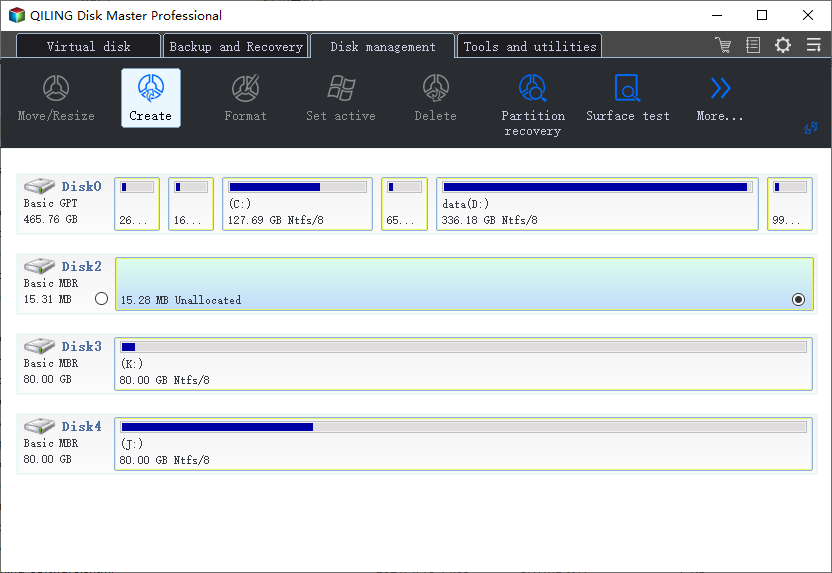
Step 2: Set a new partition label, file system (NTFS/FAT32), and cluster size to the selected partition, and click "Proceed" to continue.
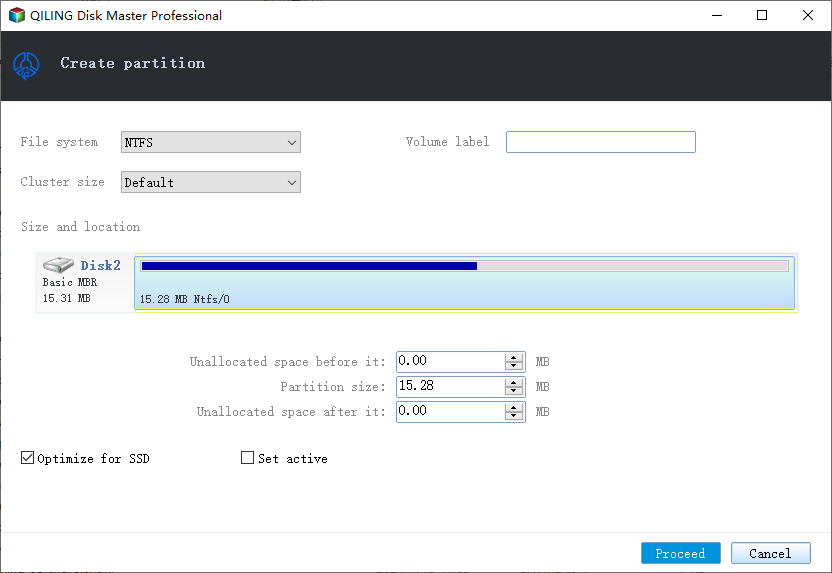
#2. Use Disk Management - Medium
It's an optimal way to manage the unallocated space using Windows 10 Disk Management. Here are the steps to create a new partition:
Step 1: Right-click Windows icon and select Disk Management.
Step 2: Locate and right-click on unallocated space in Disk Management, select "New Simple Volume".
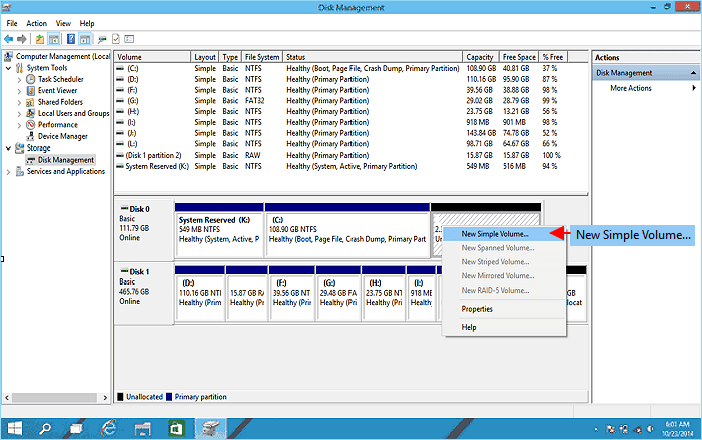
Step 3: Specify the partition size and click "Next" to continue.
Step 4: Set a drive letter, file system - NTFS, and other settings to the new partitions. Click "Finish" to complete creating a new partition.
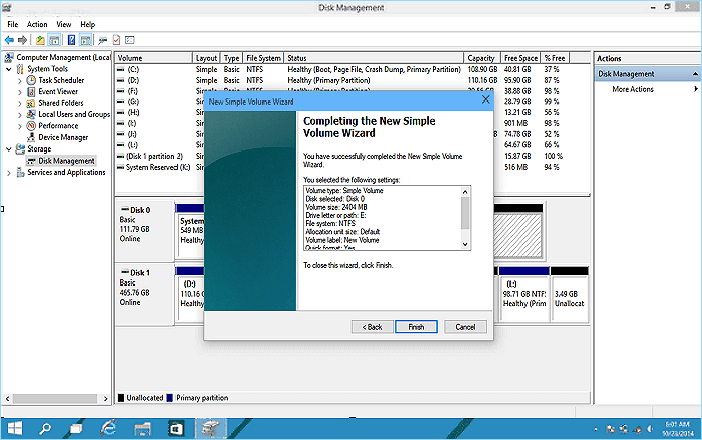
#3. Use DiskPart CMD Command - Hard
Step 1: Open DiskPart command prompt:
Type cmd in Search > Right-click Command Prompt > "Open as Administraor" > Type diskpart and hit Enter.
Step 2: Type the following command and hit Enter each time:
- list disk
- select disk 0 (Replce 0 with your disk number)
- create partition primary size=x or create partition logical size=x (replace x with partition size in MB)
- a ssign letter=H (Replace H with a new partition drive letter)
- format fs=ntfs quick
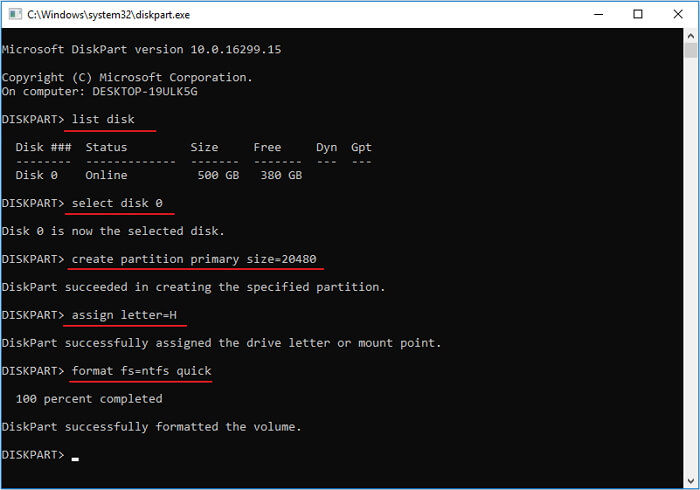
Step 3: Type exit to close DiskPart.
If you need to create more than one partition with the unallocated disk space, repeat the above steps with the chosen tool.
2. Extend an Existing Partition Using Unallocated Space
You may also use the following three tools to extend partition with existing unallocated space on your disk:
#1. Use Qiling Partition Master
Applies to: Adding unallocated space to an existing partition is ideal to fully utilize the free space, meanwhile, solve the low disk space warning on the target partition.
#1. Use Qiling Partition Master - Beginners 1st Choice
Qiling Partition Master allows users to drag and move unallocated space to anywhere they like. Let's see how to flexibly extend a partition even the unallocated space is not adjacent:
Step 1. You should first select the drive/partition that want to adjust its size and select "Resize/Move" in the "Disk management" page.
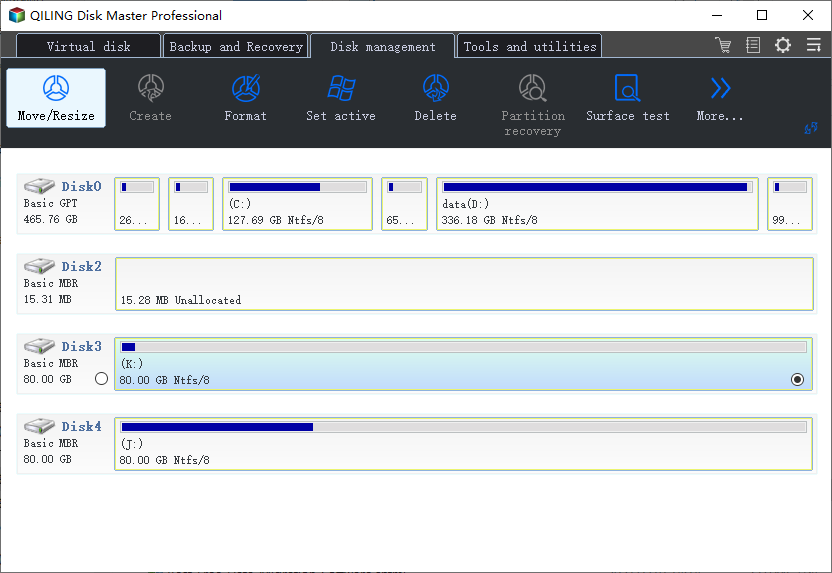
Step 2. Extend the Target Partition
(1) To shrink the partition, simply drag one of its ends to free up unallocated space and click "Proceed" to start resize the partition.
(2) To extend the partition, make sure that there is unallocated space aside (if there isn't, follow the above steps to create some). In the same way, drag your mouse into the unallocated space and click "Proceed" to start resize the partition.
(3) To move a partition position, you need to leave unallocated space next to the target partition. If no, free up some unallocated space first. Then drag the whole partition left or right to adjust its position and click "Proceed" to start move the partition.
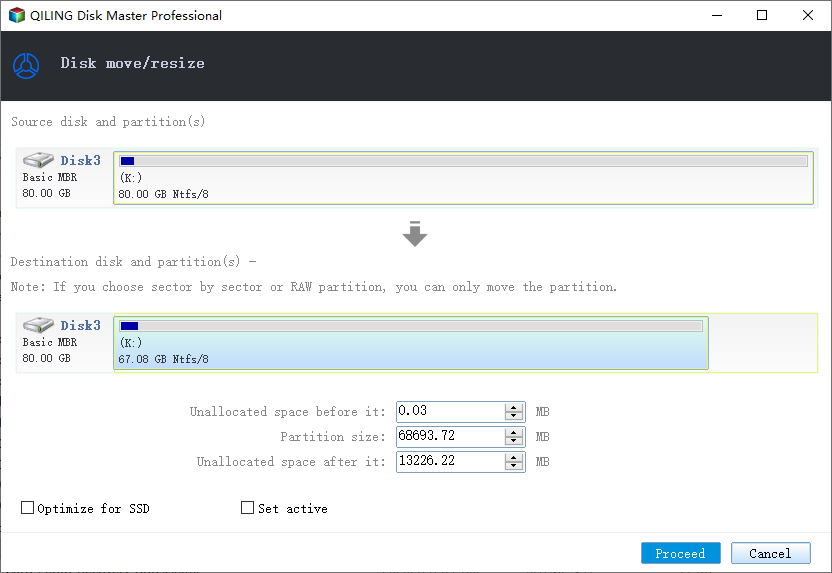
#2. Use Disk Management - For experienced users
Step 1: Open Disk Management by right-clicking on Windows icon and select "Disk Management".
Step 2: Right-click on the partition that you want to extend and select "Extend Volume".
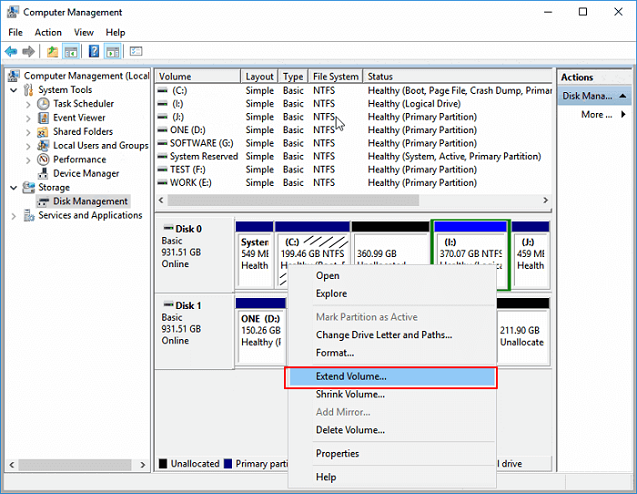
Step 3: Click "Next" to continue, adjust the size of unallocated space to add to the selected partition.
Step 4: Click "Next" and "Finish" to complete the process.
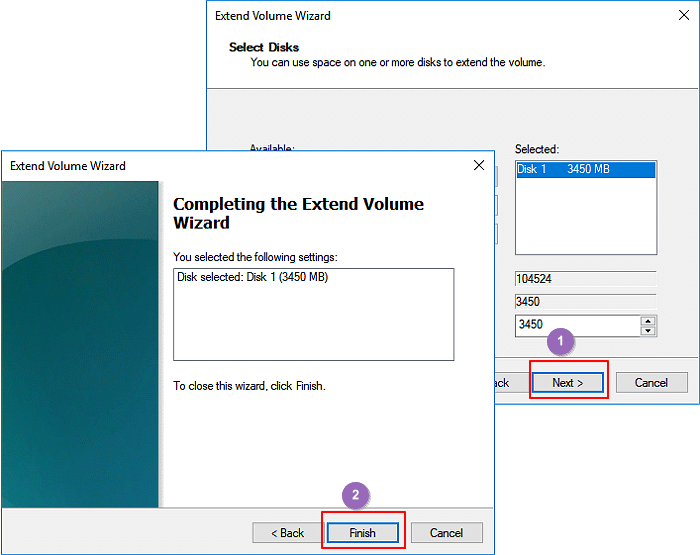
#3. Usk DiskPart Command - For professionals
Step 1: Open DiskPart command prompt:
Type CMD in Search > Right-click Command Prompt > Select "Run as Administrator" > Type diskpart and hit Enter.
Step 2: Type the following command links and hit Enter each time:
- list disk
- select disk 0 (replace 0 with your disk number)
- list volume
- select volume x (replace x with the target partition number that you want to extend)
- extend size=number (adjust and add unallocated space to the selected volume in MB)
Step 3: Type exit to close DiskPart.
Bonus Tip: Fix Unallocated Space in Windows 11/10 Can't Use Error
Applies to: Fix unallocated space in Windows 11/10 or Windows 8/7 computer cannot be used error.
If you cannot create or extend partition using the unallocated space, don't worry. Follow through the guidelines here, you'll make full use of the unallocated space on your disk:
1st. Check Disk Capacity - Larger or Smaller than 2TB
Step 1: Open Windows Disk Management.
Step 2: Check the total disk capacity:
If the disk is larger than 2TB, continue with Step 3.
Step 3: Right-click the disk and select "Properties".
If the disk is with MBR, convert it to GPT as guided in the 2nd tutorial.
If your disk is smaller than 2TB but you cannot use the unallocated space in Disk Management with "Extend Volume greyed out" or "New Simple Volume greyed out" error, let Qiling Partition Master help. You can directly revet to the above tutorials to create a partition or extend partition using Qiling partition manager.
2nd. Convert MBR to GPT
If your disk is larger than 2TB and it's with MBR, convert it to GPT using Qiling Partition Master:
Run Qiling Partition Master > Click target disk > click "More..." options > Select "MBR -> GPT".
After this, you can then continue with the above steps, you'll be able to allocate the unallocated space again.
Conclusion
On this page, we covered 6 ways to help Windows users to allocate unallocated disk space on Windows 10/8/7 using Qiling Partition Master, Disk Management, and DiskPart.
You can either create a new partition or extend existing partitions to make use of the unallocated space on your disk. Compared to Disk Management and DiskPart, Qiling Partition Master is exclusively designed for Windows OS and Windows Server users to manage their hard disks and partitions.
It's much easier to handle, and most of all, smarter than any native Windows disk management and DiskPart.
People Also Ask About Unallocated Space
For further questions and answers related to unallocated space on Windows 11/10 or even older Windows systems, check the answers below. You may get a satisfying answer:
1. Where does unallocated space come from?
Where does unallocated space come from? Generally, unallocated space is generated by manufacturers as a default space state on storage devices, especially on the hard drive and SSD disk. You can also get unallocated space when you delete a partition or you shrank a partition.
2. What to do if Disk Management option greyed out on unallocated space?
Don't worry when you cannot allocate unallocated space with Windows disk management as its "Extend Volume" and "New Simple Volume" options are greyed out.
Here are two ways to help you out:
[1]. Use Qiling Partition Master and continue allocating the unallocated space;
[2]. Convert the hard disk with unallocated space to GPT and retry again.
3. Can't extend C drive without unallocated space?
When there is no unallocated space on your hard drive, you may not be able to extend C drive using Disk Management. You must delete or shrink partition next to C drive so as to free up space.
Qiling Partition Maser offers another option for you that you can allocate free space from other partitions to your C drive with its Allocate Space feature. Or, you can also use its Resize/Move feature to flexibly move free space to C drive.
Check: Move Space from D Drive to C Drive, or Transfer Disk Space from One Partition to Another.
Related Articles
- How to Partition Hard Drive Disk without Formatting
- Clone Hard Drive to Larger Drive Without Reinstalling Windows and Programs
- Fix Diskpart Clean Not Working on Disk/USB/SD Card [5+ Fixes]
- MBR VS GPT | What's the Difference and Which Is Better
- How-to: Create USB Bootable Partition Manager to Manage Partitions Safely
- 3 Easy Ways on How To View Partitions (2022)